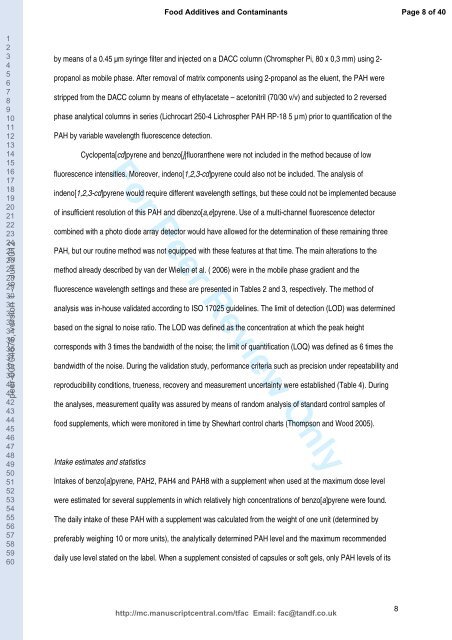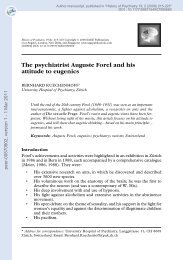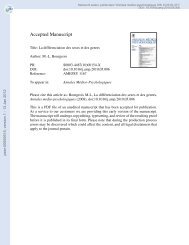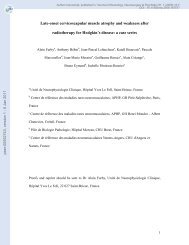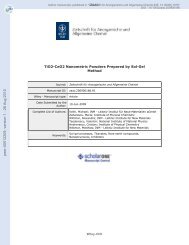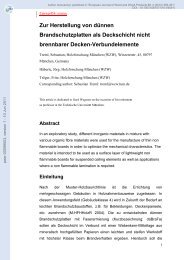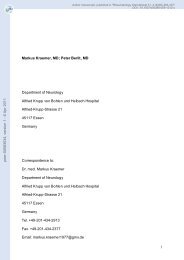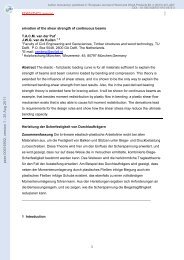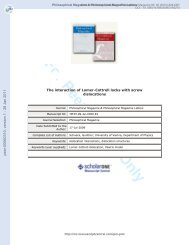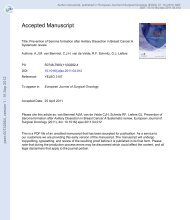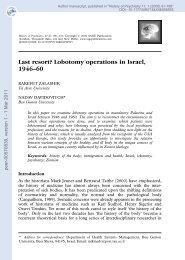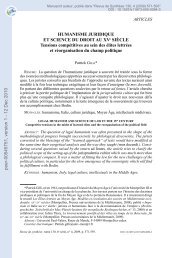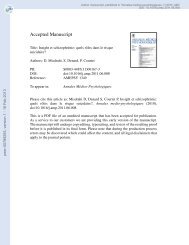Monitoring of Polycyclic Aromatic Hydrocarbons (PAH) in food ...
Monitoring of Polycyclic Aromatic Hydrocarbons (PAH) in food ...
Monitoring of Polycyclic Aromatic Hydrocarbons (PAH) in food ...
You also want an ePaper? Increase the reach of your titles
YUMPU automatically turns print PDFs into web optimized ePapers that Google loves.
1<br />
2<br />
3<br />
4<br />
5<br />
6<br />
7<br />
8<br />
9<br />
10<br />
11<br />
12<br />
13<br />
14<br />
15<br />
16<br />
17<br />
18<br />
19<br />
20<br />
21<br />
22<br />
23<br />
24<br />
25<br />
26<br />
27<br />
28<br />
29<br />
30<br />
31<br />
32<br />
33<br />
34<br />
35<br />
36<br />
37<br />
38<br />
39<br />
40<br />
peer-00704676, version 1 - 6 Jun 2012<br />
41<br />
42<br />
43<br />
44<br />
45<br />
46<br />
47<br />
48<br />
49<br />
50<br />
51<br />
52<br />
53<br />
54<br />
55<br />
56<br />
57<br />
58<br />
59<br />
60<br />
by means <strong>of</strong> a 0.45 µm syr<strong>in</strong>ge filter and <strong>in</strong>jected on a DACC column (Chromspher Pi, 80 x 0,3 mm) us<strong>in</strong>g 2-<br />
propanol as mobile phase. After removal <strong>of</strong> matrix components us<strong>in</strong>g 2-propanol as the eluent, the <strong>PAH</strong> were<br />
stripped from the DACC column by means <strong>of</strong> ethylacetate – acetonitril (70/30 v/v) and subjected to 2 reversed<br />
phase analytical columns <strong>in</strong> series (Lichrocart 250-4 Lichrospher <strong>PAH</strong> RP-18 5 µ m) prior to quantification <strong>of</strong> the<br />
<strong>PAH</strong> by variable wavelength fluorescence detection.<br />
Cyclopenta[cd]pyrene and benzo[j]fluoranthene were not <strong>in</strong>cluded <strong>in</strong> the method because <strong>of</strong> low<br />
For Peer Review Only<br />
fluorescence <strong>in</strong>tensities. Moreover, <strong>in</strong>deno[1,2,3-cd]pyrene could also not be <strong>in</strong>cluded. The analysis <strong>of</strong><br />
<strong>in</strong>deno[1,2,3-cd]pyrene would require different wavelength sett<strong>in</strong>gs, but these could not be implemented because<br />
<strong>of</strong> <strong>in</strong>sufficient resolution <strong>of</strong> this <strong>PAH</strong> and dibenzo[a,e]pyrene. Use <strong>of</strong> a multi-channel fluorescence detector<br />
comb<strong>in</strong>ed with a photo diode array detector would have allowed for the determ<strong>in</strong>ation <strong>of</strong> these rema<strong>in</strong><strong>in</strong>g three<br />
<strong>PAH</strong>, but our rout<strong>in</strong>e method was not equipped with these features at that time. The ma<strong>in</strong> alterations to the<br />
method already described by van der Wielen et al. ( 2006) were <strong>in</strong> the mobile phase gradient and the<br />
fluorescence wavelength sett<strong>in</strong>gs and these are presented <strong>in</strong> Tables 2 and 3, respectively. The method <strong>of</strong><br />
analysis was <strong>in</strong>-house validated accord<strong>in</strong>g to ISO 17025 guidel<strong>in</strong>es. The limit <strong>of</strong> detection (LOD) was determ<strong>in</strong>ed<br />
based on the signal to noise ratio. The LOD was def<strong>in</strong>ed as the concentration at which the peak height<br />
corresponds with 3 times the bandwidth <strong>of</strong> the noise; the limit <strong>of</strong> quantification (LOQ) was def<strong>in</strong>ed as 6 times the<br />
bandwidth <strong>of</strong> the noise. Dur<strong>in</strong>g the validation study, performance criteria such as precision under repeatability and<br />
reproducibility conditions, trueness, recovery and measurement uncerta<strong>in</strong>ty were established (Table 4). Dur<strong>in</strong>g<br />
the analyses, measurement quality was assured by means <strong>of</strong> random analysis <strong>of</strong> standard control samples <strong>of</strong><br />
<strong>food</strong> supplements, which were monitored <strong>in</strong> time by Shewhart control charts (Thompson and Wood 2005).<br />
Intake estimates and statistics<br />
Food Additives and Contam<strong>in</strong>ants<br />
Intakes <strong>of</strong> benzo[a]pyrene, <strong>PAH</strong>2, <strong>PAH</strong>4 and <strong>PAH</strong>8 with a supplement when used at the maximum dose level<br />
were estimated for several supplements <strong>in</strong> which relatively high concentrations <strong>of</strong> benzo[a]pyrene were found.<br />
The daily <strong>in</strong>take <strong>of</strong> these <strong>PAH</strong> with a supplement was calculated from the weight <strong>of</strong> one unit (determ<strong>in</strong>ed by<br />
preferably weigh<strong>in</strong>g 10 or more units), the analytically determ<strong>in</strong>ed <strong>PAH</strong> level and the maximum recommended<br />
daily use level stated on the label. When a supplement consisted <strong>of</strong> capsules or s<strong>of</strong>t gels, only <strong>PAH</strong> levels <strong>of</strong> its<br />
http://mc.manuscriptcentral.com/tfac Email: fac@tandf.co.uk<br />
8<br />
Page 8 <strong>of</strong> 40


